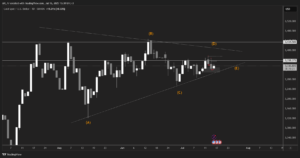The Reserve Bank of Australia lifted interest rates to the highest in 10 years with an 8th consecutive rate hike on Tuesday. AUD/USD fell ahead of the announcement on Monday before posting a modest recovery once the decision had been made on Tuesday.
· AUD/USD higher on Tuesday after 8th RBA rate hike.
· Dollar posts biggest daily gain in 2 weeks after service sector PMI
· Wall Street tanks with Dow falling 500 points
· European shares to open higher
The Aussie dollar had been hanging near a 1-week low as last minute jitters prompted traders to price in an early pause to the rate hiking cycle. The fears proved unfounded after the RBA hiked by 25 basis points to 3.10%, the highest since October 2012.
RBA Governor Philip Lowe said ‘The Board expects to increase interest rates further over the period ahead, but it is not on a pre-set course’.
Inflation is still rising in Australia with CPI sitting at 6.9% y/y as of October despite the many rate hikes. This would imply further hikes ahead, which should offer some support to AUD- though it’s performance in cross forex pairs might be a better guide versus King dollar.
USD picks up steam after ISM data
The dollar index DXY sits just above 105 following a 0.7% gain on Monday. The biggest daily rise in a year (November ‘21) came after service sector data caused traders to reassess upwards their expectations for a larger Fed rate hike at its December meeting.
The ISM Services PMI unexpectedly expanded (a reading over 50) when a contraction had been predicted by economists.
The one-two punch of the positive surprise in the data and the dollar getting oversold to a 5-month low setup the big daily jump.
Markets had been pricing in increasingly dovish expectations for the FOMC meeting this month, with a favoured 50 basis point hike starting to creep down towards 25 basis points. After Powell’s slight dovish pivot in a speech last week, 75 basis points still seems off the table but the strength of the service sector (which accounts for 2/3rds of the US economy) means a 25 basis point hike also seems unlikely.
Looking ahead, it’s possible further short-covering could see the dollar unwind some more of its big November loss, particularly against currencies where central banks have already pivoted back to single 25 basis point hikes.
Wall Street tanks
In a mirror image of the gains in the US dollar was the fall in US equities. The Dow Jones slumped 480 points while the S&P 500 lost 1.7%.
Fears that an enduringly hawkish Fed will keep raising borrowing costs for companies and possibly tip the economy into a recession sent stocks tumbling.
The shock expansion in service sector data came on the back of a strong Payrolls data on Friday. Stocks had been able to rally back after an initial drop-off following the jobs data but a repeat performance could be hard to come by.
Tech stocks were again leading the direction of the market, this time to the downside. The Nasdaq slid 1.93% – leaving it still down 26% on the year.
European market open
European stocks look set for a lower open on Tuesday, tracking the weakness on Wall Street. The FTSE 100 looks set to open at 7,569 while the DAX is at 14,435.
It was also a more subdued trading day in Asia on Tuesday after rapid gains made on Monday when Chinese authorities loosened some Covid restrictions.
Disclaimer: This article is not investment advice or an investment recommendation and should not be considered as such. The information above is not an invitation to trade and it does not guarantee or predict future performance. The investor is solely responsible for the risk of their decisions. The analysis and commentary presented do not include any consideration of your personal investment objectives, financial circumstances, or needs.
Sources: Bloomberg, CNBC, Reuters
Original article provided by Trading Writers





